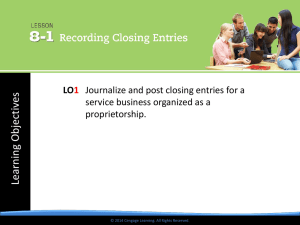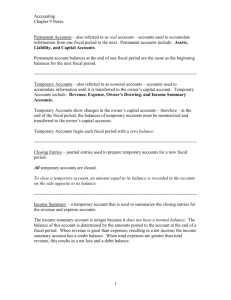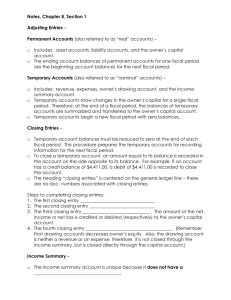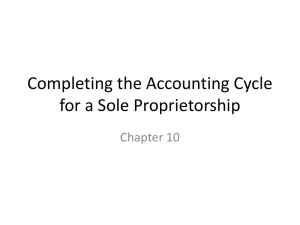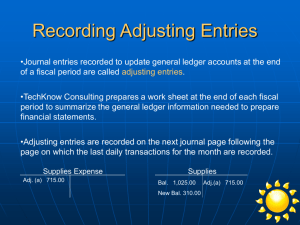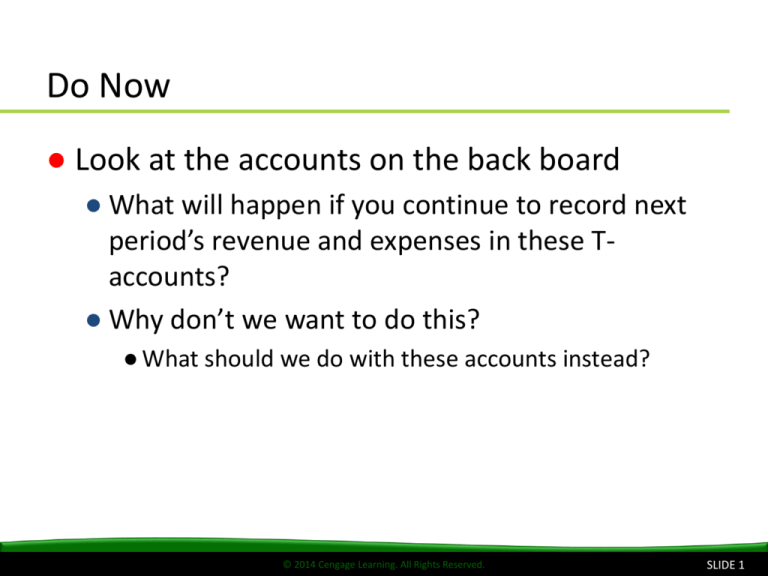
Do Now
● Look at the accounts on the back board
● What will happen if you continue to record next
period’s revenue and expenses in these Taccounts?
● Why don’t we want to do this?
● What should we do with these accounts instead?
© 2014 Cengage Learning. All Rights Reserved.
SLIDE 1
Lesson 8-1
Need for Permanent and Temporary Accounts
LO1
● Accounts used to accumulate information
from one fiscal period to the next are called
permanent accounts.
● Permanent accounts are also referred to as real
accounts.
● Include asset and liability accounts and owner’s
capital account
● Ending account balances for one fiscal period are
beginning accounts balances for next fiscal period
© 2014 Cengage Learning. All Rights Reserved.
SLIDE 2
Need for Permanent and Temporary Accounts
● Accounts used to accumulate information
until it is transferred to the owner’s capital
account are called temporary accounts.
● Temporary accounts are also referred to as
nominal accounts.
● Include revenue, expense, and owner’s drawing
accounts plus INCOME SUMMARY account
● Balances summarized and transferred to owner’s
capital account
● Begin new fiscal period with zero balances
© 2014 Cengage Learning. All Rights Reserved.
SLIDE 3
Lesson 8-1
Need for Closing Temporary Accounts
LO1
● Journal entries used to prepare temporary
accounts for a new fiscal period are called closing
entries.
● The temporary account balances must be
reduced to zero at the end of each fiscal period.
● Prepares temporary accounts for recording
information about next fiscal period (Matching
Expenses with Revenue)
● Net income for next fiscal period would be difficult to
calculate with amounts from several fiscal periods
present
© 2014 Cengage Learning. All Rights Reserved.
SLIDE 4
Need for Closing Temporary Accounts
● To close temporary account, amount equal to
its balance is recorded in account on side
opposite to its balance
● Temporary account titled INCOME SUMMARY
is used to summarize closing entries for
revenue and expense accounts
● Does not have normal balance side
● Balance determined by amounts posted to
account at end of fiscal period
© 2014 Cengage Learning. All Rights Reserved.
SLIDE 5
Lesson 8-1
Need for the Income Summary Account
LO1
● When revenue is greater than total expenses, resulting in a net income,
the Income Summary account has a credit balance, as shown in the T
account.
Income Summary
Debit
Total expenses
Credit
Revenue (greater than expenses)
(Credit balance is the net income.)
● When total expenses are greater than revenue, resulting in a net loss, the
Income Summary account has a debit balance, as shown in the T account.
Income Summary
Debit
Total expenses (greater than revenue)
(Debit balance is the net loss.)
© 2014 Cengage Learning. All Rights Reserved.
Credit
Revenue
SLIDE 6
Quick Break
● Read Think Like an Accountant on page 218
● Answer questions 1-3 with a partner
● Be prepared to discuss
● Were the accounts this man dealt with temporary
or permanent accounts?
© 2014 Cengage Learning. All Rights Reserved.
SLIDE 7
Need for the Income Summary Account
● INCOME SUMMARY is also closed at end of fiscal
period when net income/loss is recorded because
it is a temporary account
● Four closing entries:
1.
2.
3.
4.
Entry to close income statement accounts with credit
balances
Entry to close income statement accounts with debit
balances
Entry to record net income or net loss and close INCOME
SUMMARY
Entry to close owner’s drawing account
● All information found on Income Statement and Balance Sheet
columns of work sheet
© 2014 Cengage Learning. All Rights Reserved.
SLIDE 8
Lesson 8-1
Closing Entry for an Income Statement
Account with a Credit Balance
Closing
Sales
5,820.00 Bal.
(New Bal.
LO1
5,820.00
0.00)
Income Summary
Closing (revenue) 5,820.00
(Debit to close)
3 Debit
Heading 1
Date 2
4
© 2014 Cengage Learning. All Rights Reserved.
Credit
SLIDE 9
Lesson 8-1
Closing Entry for Income Statement
Accounts with Debit Balances
Income summary debited
for total of expense
accounts balances and
not entered in amount
column until all expenses
have been journalized
and total calculated
LO1
(Credit to close)
Debit Amount
Income Summary
Date
Credit
© 2014 Cengage Learning. All Rights Reserved.
SLIDE 10
Lesson 8-1
Closing Entry to Record Net Income or Loss
and Close the Income Summary Account
LO1
(Capital: credit to
record net income)
Debit
2
(Income Summary:
debit to close)
Date 1
3
Credit
© 2014 Cengage Learning. All Rights Reserved.
SLIDE 11
Lesson 8-1
Closing Entry for the Owner’s Drawing
Account
LO1
(Credit to close)
Date 1
2
Debit
3
Credit
© 2014 Cengage Learning. All Rights Reserved.
SLIDE 12
Class Activity:
● Five cups labeled either Sales, Expenses,
Income Summary, Drawing, and Capital
● Pieces of paper have titles and amounts of Sales,
$12,000…Expenses, $9,800…Income Summary,
blank…Drawing, $200…Capital, $2,390
● Transfer strips of paper to appropriate cup to exemplify
four types of closing entries
● Others evaluate/assess decision by classmate
● GET OUT WHITEBOARDS!
© 2014 Cengage Learning. All Rights Reserved.
SLIDE 13
Lesson 8-1
Lesson 8-1 Audit Your Understanding
1. What do the ending balances of permanent
accounts for one fiscal period represent at
the beginning of the next fiscal period?
ANSWER
Beginning balances
© 2014 Cengage Learning. All Rights Reserved.
SLIDE 14
Lesson 8-1
Lesson 8-1 Audit Your Understanding
2. What do the balances of temporary accounts
show?
ANSWER
Changes in the owner’s capital account for
a single fiscal period
© 2014 Cengage Learning. All Rights Reserved.
SLIDE 15
Lesson 8-1
Lesson 8-1 Audit Your Understanding
3. List the four closing entries.
ANSWER
1. An entry to close income statement accounts
with credit balances.
2. An entry to close income statement accounts
with debit balances.
3. An entry to record net income or net loss and
close the Income Summary account.
4. An entry to close the owner’s drawing account.
© 2014 Cengage Learning. All Rights Reserved.
SLIDE 16
Apply and Analyze
● As a class/in partners: 8-1 Work Together
● Individually: 8-1 On-Your-Own
● Create bullet points covering important 8-1
points to remember
● Then form questions around those main points for
classmates to answer (ring bell if you know the
answer)
● Student with most correct answers receives…
© 2014 Cengage Learning. All Rights Reserved.
SLIDE 17
Closure
● Informal Writing: explain the types of closing
entries that must be completed within one
minute
● Red, yellow, green
© 2014 Cengage Learning. All Rights Reserved.
SLIDE 18



